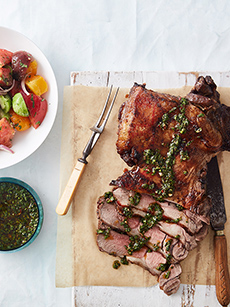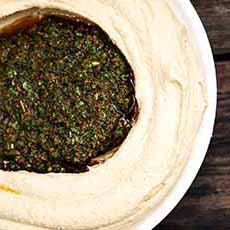TIP OF THE DAY: Chermoula Sauce
|
Last night at a nine-course feast at the home of our wine editor, we were served a dish of scallops, sautéed greens and a hearty topping of freshly-made pesto.
A conversation ensued among the nut-averse and lactose-intolerant in attendance, that they didn’t use pesto because of the cheese or the nuts. There’s an easy alternative: chermoula, a Middle Eastern marinade and sauce popular in the cuisines of Algeria, Libya, Morocco and Tunisia. As with pesto recipes, there are countless regional variations both in ingredients and proportions. But chermoula usually starts with a mixture of fresh herbs (especially cilantro), olive oil, lemon juice, cumin, garlic and salt. Flavorful chermoula is typically used with fish and seafood, and its green color adds brightness to what we personally refer to as “beige and brown foods.” It is also used to flavor meat, poultry and vegetable dishes. Variations include black pepper, fresh coriander, ground chiles, onion, pickled lemons and saffron, among other ingredients. |
 [1] At Off The (Meat) Hook, it’s used to coat broiled halibut. Here’s the recipe (photo © Off The Meat Hook). |
|
|
|
||
|
|
RECIPE: CHERMOULA SAUCE In the Middle East, chermoula is traditionally made with a mortar and pestle. In our tests making pesto, the mortar and pestle produced a more flavorful pesto than the food processor. So we pulled it out to make this recipe. Feel free to switch on the food processor instead. This recipe is a Moroccan variation, with paprika. As with pesto, it is easy to make. Prep time is just 10 minutes. You can make extra and freeze it. Ingredients For 1 Cup 1. COMBINE all the ingredients in a mortar or food processor. Grind or pulse into a thick paste. It’s that easy! 2. STORE the chermoula in a jar with a tight-fitting lid. It will last for up to 3 weeks in the fridge, needing only to be stirred. 3. FREEZE extra in the compartments of an ice cube tray that has been sprayed with nonstick olive oil spray. When the cubes have frozen, remove them to a freezer bag. This weekend we perused a book that had been sent to us on The Food of Oman, a sultanate on the southern end of the Arabian Peninsula. When we pulled it out of its packaging, our first reaction was, “We have no time to figure out the cooking of Oman.” But as we thumbed our way through the book, we wanted to eat everything! If you enjoy learning new cuisines, or know someone who does, pick up a copy. The author, an American food writer who lived in the Middle East, takes readers on a journey that is delightful. *You can include the small stems that attach the leaves to the main stalks. †A fruity style (as opposed to peppery) is preferable. |
|
|
|
||


 Hummus & Chermoula[/caption]
Hummus & Chermoula[/caption]

